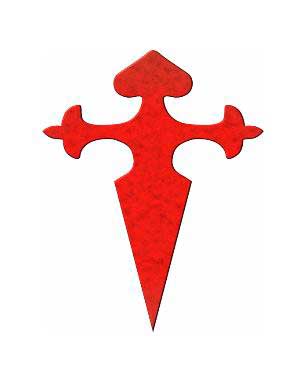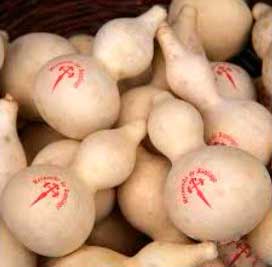WHAT DID A PILGRIM ON THE CAMINO LOOK LIKE IN THE PAST? WHICH SYMBOLS HAVE BEEN KEPT?

If you visit Galicia you will see countless people walking towards Santiago, often with backpacks and hikers attire. Many of these travellers also carry a long staff with a shell attached to the handle and look some what dishevelled. These people are holy pilgrims making the centuries old pilgrimage known as “el Camino de Santiago” (the way of St. James). It is the route, or routes, that they follow that are known as “El Camino” and the oldest one starts in France some 900km (650 miles) from its ultimate destination. The serious pilgrims, who walk the entire route, can expect a journey of approximately one months duration, with the added bonus of very sore feet. Many do however claim to have a revelation on achieving their goal. There is also a book you can sign as proof of your journey’s completion at Santiago de Compostela’s pilgrims office near the Cathedral.
This route or routes have been walked since Middle Ages but pilgrim´s costume and accessories have changed a lot.
In the middle ages no less than 4 Popes proscribed the pilgrim’s dress – a long cloak, broad hat, a staff and gourd, a pouch to hold alms and a scrip or satchel. The broad hats to protect them from the sun, the cloak to counter cold and rain, the satchel for food, the gourd for water and the staff for defence and support over rough ground. The scallop shell, which the pilgrims wore soon, became the symbol of the Jacobean pilgrimage. This was to identify them as pilgrims and not vagabonds. The less material belongings they carried the more severe their hardships.
 Sir Walter Raleigh said it beautifully in the first verse of his poem – The Passionate Man’s Pilgrimage) the night before he was to be hanged. (He was imprisoned in the Tower of London the night before his execution on a charge of treason. He languished there for thirteen years before being released in order to lead an expedition to South America in search of gold. When he returned unsuccessful he was beheaded in 1618 on the old charge of treason.)
Sir Walter Raleigh said it beautifully in the first verse of his poem – The Passionate Man’s Pilgrimage) the night before he was to be hanged. (He was imprisoned in the Tower of London the night before his execution on a charge of treason. He languished there for thirteen years before being released in order to lead an expedition to South America in search of gold. When he returned unsuccessful he was beheaded in 1618 on the old charge of treason.)
Give me my scallop shell of quiet,
My staff of faith to walk upon,
My scrip of joy, immortal diet,
My bottle of salvation,
My gown of glory, hope’s true gage,
And thus I’ll take my pilgrimage.
We can also analyze the symbolic meaning of the traditional pilgrim´s accessories.
Pilgrim’s shell (scallop shell))
The scallop shell has long been the symbol of the Camino de Santiago. Over the centuries the scallop shell has taken on mythical, metaphorical and practical meanings, even if its relevance may actually derive from the desire of pilgrims to take home a souvenir.

Two versions of the most common myth about the origin of the symbol concern the death of Saint James, who was martyred by beheading in Jerusalem in 44 AD.
Version 1: After James’ death, his disciples shipped his body to the Iberian Peninsula to be buried in what is now Santiago. Off the coast of Spain a heavy storm hit the ship, and the body was lost to the ocean. After some time, however, the body washed ashore undamaged, covered in scallops.
Version 2: After James’ death his body was mysteriously transported by a ship with no crew back to the Iberian Peninsula to be buried in what is now Santiago. As James’ ship approached land, a wedding was taking place on the shore. The young groom was on horseback, and on seeing the ship approaching, his horse got spooked, and the horse and rider plunged into the sea. Through miraculous intervention, the horse and rider emerged from the water alive, covered in seashells.
As the symbol of the Camino de Santiago, the shell is seen very frequently along the trails. The shell is seen on posts and signs along the Camino in order to guide pilgrims along the way. The shell is even more commonly seen on the pilgrims themselves. Wearing a shell denotes that one is a traveler on the Camino de Santiago. Most pilgrims receive a shell at the beginning of their journey and either attach it to them by sewing it onto their clothes or wearing it around their neck or by simply keeping it in their backpack.
The scallop shell also served practical purposes for pilgrims on the Camino de Santiago. The shell was the right size for gathering water to drink or for eating out of as a makeshift bowl.
The scallop shell also acts as a metaphor. The grooves in the shell, which come together at a single point, represent the various routes pilgrims traveled, eventually arriving at a single destination: the tomb of James in Santiago de Compostela
The cross of Santiago
It simulates a Latin cross and a sword with three lilies in her arms and grip. It may have originated in the time of the crusades, when knights wore small crosses with sharp bottom to nail them into the floor and perform their devotions. The sword represents the chivalrous character of St. James his way of martyrdom.

Gourd
Its empty fruit served travelers to carry water in medieval times. It has been a basic equipment for every pilgrim for centuries. This is the reason why eventually become a symbol of the Camino de Santiago and an inseparable image of the pilgrims. Pilgrims generally attached their pumpkin-flasks to their walking staff.
As you can see, most of these symbols are present nowadays on the Camino de Santiago and they are without a doubt the most iconic and traditional souvenirs.
Standing on the main square of Santiago de Compostela, Obradoiro square, you can share the joy of pilgrims who have completed the Camino de Santiago and “actors” wearing traditional medieval pilgrim costumes. One of them was the popular Zapatones. Juan Carlos Lema Balsas known as Zapatones , a man who was part of the landscape of Compostela, in which, with his Dark Brown pilgrim layer white beard who receive Pilgrim ended and was photographed with them, died at age 61.
Zapatones was the official informer of pilgrims and visitors that arrived at the Cathedral of Compostela. You could always go and talk to him and ask him about any information about the cathedral, Santiago, what to do and so on. He was always more than happy to pose for a picture as well.

Buen Camino, amigos!
Anxo Saco




Comments
Fern
The oldest route is known to be the “Camino Primitivo” (starting at San Salvador Cathedral in Oviedo) and is about 340kms.
Then came the “Camino Aragonés” (originally started in Arles, France)
Camino Francés came third 🙂